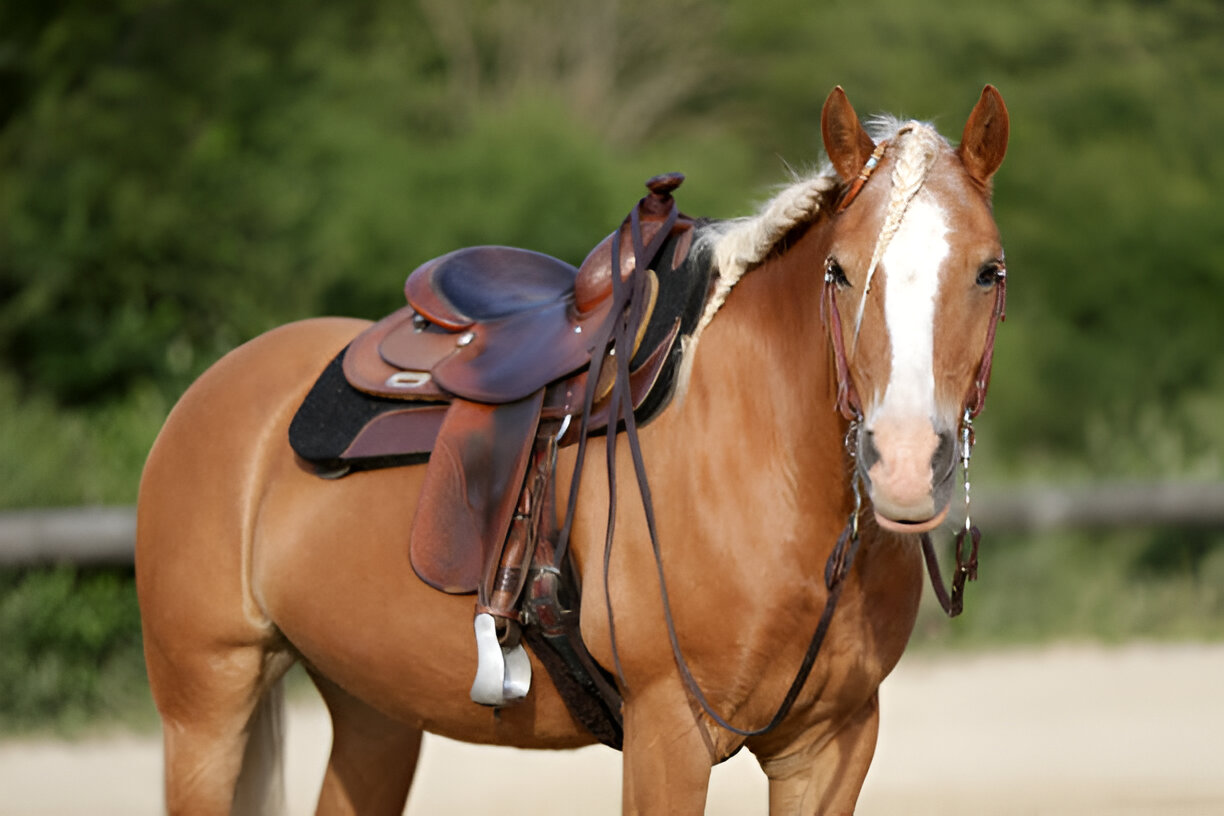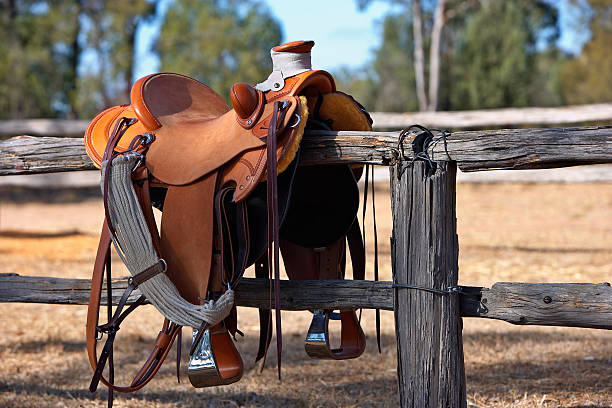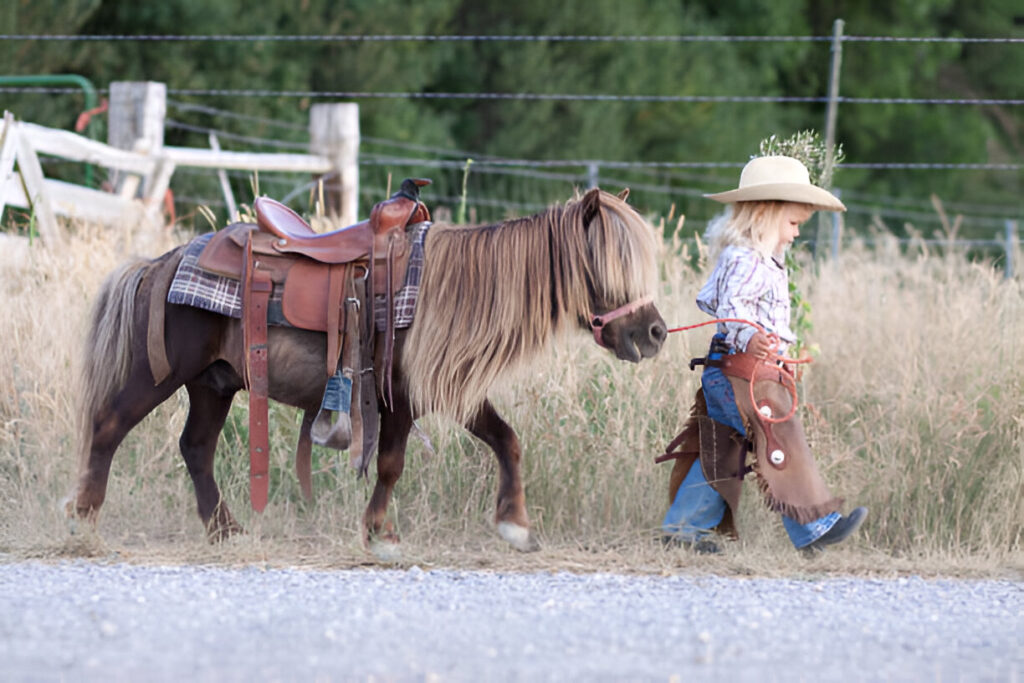
The Complete Guide to Australian Saddles
History, Features, Benefits & Care
The Australian stock saddle stands as a testament to innovative design born from necessity. Forged in the rugged Australian outback, this unique saddle blends elements of traditional English and Western designs to create what many riders consider the perfect balance of security and comfort. Whether you’re an experienced horse rider seeking better stability on challenging terrain or a newcomer looking for your first saddle, understanding the unique aspects of Australian saddles can significantly enhance your riding experience.
I’ve spent over two decades working with these remarkable saddles, witnessing firsthand how they’ve evolved while maintaining their distinctive character. In this comprehensive guide, we’ll explore everything from their fascinating history to practical advice on fitting, care, and maintenance. So settle in as we embark on this journey through the world of Australian saddles.
Table of Contents
The Rich History of Australian Saddles
The Australian stock saddle has evolved over approximately 150 years, beginning as an adaptation of the English all-purpose dressage saddle that European settlers brought to the continent. These early English saddles featured a deep seat and a knee roll at the front to help riders maintain their position, but they weren’t designed for the harsh conditions and challenging terrain of the Australian outback.
As settlers faced the unique challenges of managing livestock across vast, rugged landscapes, they needed more secure seating than traditional English saddles could provide. The early adaptations began with increasing the size of the knee rolls, which eventually evolved into what we now recognize as the distinctive knee pads (or “poleys”) of the Australian saddle.

A horse equipped with a traditional Australian stock saddle ready for work
Evolution Through Necessity
The initial adaptations were simple: instead of a knee roll under the outer flaps, which gave a recessed shape around 1½ inches deep, saddle makers attached a knee pad to the outer flap. These were positioned low and served much the same purpose as the knee roll, with a similar height of around 1½ to 2 inches.
This innovation was quickly accepted, and as competition among saddle makers increased, the knee pads grew larger and were repositioned higher on the saddle. Though still called “knee pads,” they came to be positioned to contact the rider’s upper thigh rather than the knee itself. This gave riders significantly more security – if the horse suddenly stopped or the rider was thrown forward, they would lock in under and behind the kneepad.
By the late 1800s, the Australian stock saddle had become distinct from its English ancestors. Names like Jack Wieneke, often described as the “father of the Australian stock saddle,” and later Albert ‘Bertie’ Cox were instrumental in refining the design. Cox’s innovation of the “broken neck” poley in the 1920s created a flatter seat and raised the kneepads closer to the top of the pommel, allowing riders to sit more forward for better balance during fast cattle work.
“Those craftsmen knew the demands then of the Australian bush and those demands are the same today. Those craftsmen sure were right when they designed and invented the unique Australian Stock Saddle.” — Trevor James, Master Saddler
Modern Innovations
The mid-1960s saw significant changes in saddle tree design with the introduction of new materials such as fiberglass, carbon fiber, Kevlar, and polyurethanes. These materials allowed saddles to be made stronger, lighter, and with more close contact to the horse. While maintaining the original design features like the dish seat and the Australian “kneepad,” modern stock saddles have incorporated improvements such as replacing the narrow 1¼” stirrup leather with an American-style fender for increased strength and comfort.
Today’s Australian stock saddles retain their distinctive character while incorporating modern materials and design elements that improve both horse and rider comfort. They’ve gained popularity worldwide for their security, comfort on long rides, and versatility across various riding disciplines.
Key Features and Design Elements
Distinctive Components
What sets the Australian stock saddle apart from other designs are its unique components and structure. Each element has been carefully designed to enhance security, comfort, and functionality in demanding riding conditions.
Poleys (Knee Pads)
The most distinctive feature of Australian saddles is the poleys – the padded supports at the front of the saddle that help secure the rider’s legs. Unlike Western saddle swells, poleys are specifically designed to keep the rider from sliding forward. They provide crucial stability when riding downhill or when a horse stops suddenly.
Deep Seat
Australian saddles feature a notably deeper seat than English saddles, creating a more secure position for the rider. The seat was deliberately redesigned to be wider and dished to provide maximum comfort for long hours in the saddle.
High Cantle
The raised back portion of the saddle (cantle) is higher than in English saddles, which helps prevent the rider from sliding backward, particularly when riding downhill or during sudden stops.

Diagram showing the key parts of an Australian stock saddle
Stirrup Bar
The unique stirrup bar design is a safety feature that has remained constant throughout the evolution of the Australian saddle. The stirrup leather passes over it and is held in place by the upward curve at the rear end of the bar. This allows the stirrup leather to slip off and release the rider in case of a fall and drag situation.
Fenders/Leathers
Modern Australian saddles often feature wide fenders similar to Western saddles, eliminating the pinching associated with narrow stirrup leathers while increasing strength. Some designs incorporate a rotating stirrup bar that moves with the fender, eliminating stress on the strap.
Structural Elements
Saddle Tree
Originally built on carved timber trees with steel framework, modern Australian saddle trees utilize advanced materials like fiberglass, carbon fiber, and polyurethanes. These materials create stronger, lighter saddles while preventing distortion and spreading of the gullet.
Underside Construction
Modern Australian saddles typically feature sheepskin lining on the underside, providing more close contact than the old-style hair-stuffed panels. This design enhances comfort for the horse and improves weight distribution.
Girthing System
The saddle is secured with a girth attached to billets under the flaps, similar to those on a dressage saddle. A surcingle (overgirth) passing over the seat provides additional security, and many riders add a crupper at the rear and a breastcollar at the front for maximum stability.
Seat Design
The seat can range from a shallow dish to a full roll seat based on rider preference. This dish shape helps center the rider and maintain proper position during challenging riding conditions.
Benefits of Australian Saddles

For the Rider
- Enhanced Security: The poleys and deep seat provide exceptional stability, particularly valuable on rough terrain or with less predictable horses.
- Comfort for Long Rides: The design distributes rider weight evenly and provides better support for extended periods in the saddle.
- Improved Balance: The forward-positioned stirrups and secure seat help maintain proper balance even during sudden movements.
- Safety Features: The stirrup bar design helps prevent dragging accidents by releasing the rider’s foot if they fall.
- Versatility: Suitable for various disciplines from trail riding to cattle work, endurance riding, and even some competition events.
For the Horse
- Weight Distribution: The design spreads rider weight more evenly across the horse’s back, reducing pressure points.
- Stability: The secure position of the rider means less shifting and bouncing, creating a more comfortable experience for the horse.
- Forward Positioning: Australian saddles sit more forward on a horse’s back than Western saddles, positioning weight away from the sensitive lumbar region.
- Closer Contact: Modern designs provide better feel between horse and rider, enhancing communication.
- Adaptability: Available in various tree widths to accommodate different horse shapes and sizes.
“If you are not roping, but want a lightweight, balanced saddle that distributes the rider weight to minimize damage to your horse while giving the rider maximum comfort and security, the Australian Stock Saddle is for you.”
Ideal Uses for Australian Saddles
Trail Riding
The comfort and security make Australian saddles perfect for long trail rides over varied terrain. Riders appreciate the stability when navigating hills, water crossings, and rough ground.
Cattle Work
The original purpose of these saddles remains one of their strongest applications. The security during quick starts, stops, and turns makes them ideal for working cattle.
Endurance Riding
Their lightweight design and comfort for both horse and rider make Australian saddles popular choices for endurance competitions and long-distance riding.
Types of Australian Saddles
Australian saddles have diversified over the years to accommodate different riding styles and purposes. While they all maintain the core features that define Australian saddles, each type has distinct characteristics that make it suitable for specific uses.
| Saddle Type | Key Features | Best For |
|---|---|---|
| Traditional Stock Saddle | Classic design with prominent poleys, deep seat, high cantle, and traditional stirrup leathers. | All-purpose riding, cattle work, challenging terrain |
| Poley Saddle | Features extra-large knee pads (poleys) for maximum security; deeper seat. | Working with young or unpredictable horses, rough terrain |
| Half-Breed Saddle | Combines Australian features with Western-style fenders and stirrups; sometimes includes a horn. | Riders transitioning from Western saddles, general trail riding |
| Endurance Saddle | Lightweight design with minimalist structure; focused on comfort for long-distance riding. | Endurance competitions, long-distance trail riding |
| Synthetic Australian Saddle | Made with synthetic materials instead of leather; lighter weight and weather-resistant. | Wet environments, budget-conscious riders, beginners |
Notable Brands and Manufacturers
Several manufacturers have established reputations for producing high-quality Australian saddles. These include:
Australian-Based Makers
- Syd Hill Saddles – One of the oldest and most respected Australian saddle makers
- Toowoomba Saddlery – Founded in 1968, known for quality craftsmanship
- Kent Saddlery – Specializes in handcrafted saddles for working riders
- James Saddlery – Produces traditional Australian stock saddles
- Mathew Murray – Known for premium custom saddles
International Manufacturers
- Down Under Saddle Supply – One of the largest distributors in the USA
- Australian Stock Saddle Company – Founded by Colin Dangaard
- Wintec – Known for synthetic Australian saddles
- Australian Outrider – Produces affordable Australian-style saddles
- Bad Dog Ranch – Specializes in Australian saddles for North American riders
Choosing the Right Type
When selecting an Australian saddle, consider:
- Your primary riding activities (trail, work, endurance)
- Your experience level and comfort preferences
- Your horse’s build and sensitivity
- Budget considerations (quality traditional leather saddles are typically more expensive than synthetic versions)
- Climate and maintenance considerations (synthetic models are easier to maintain in wet environments)
How to Properly Fit an Australian Saddle
Proper Positioning
Australian saddles sit more forward on a horse’s back than traditional Western saddles. The stirrups are also attached in a more forward position, which puts the rider’s center of gravity and weight in a forward position rather than the middle of the spine.
The girth should be positioned 1″ to 3″ behind the horse’s front legs. This position is more comfortable for most horses and enhances performance. Before embarking on a long ride with a new saddle, take several shorter rides to allow the padding to conform to your horse’s back.
Signs of Good Fit
- The saddle sits level on the horse’s back (not tipping forward or backward)
- There’s even contact along the panels at the front of the saddle
- Clearance of 2-4 inches between the top of the withers and the top of the saddle chamber
- No pressure points causing discomfort
- The saddle stays in position during movement without sliding

Visual guide to proper Australian saddle fit
Warning: Signs of Poor Fit
- Horse showing signs of discomfort (tail swishing, pinned ears, reluctance to move forward)
- Development of dry spots or white hairs under the saddle area
- Saddle consistently sliding to one side
- Front of saddle sitting too high (tree too narrow)
- Front of saddle sitting too low (tree too wide)
Rider Fit Considerations
Finding the right saddle size for the rider is just as important as proper fit for the horse. Australian saddles are measured differently than Western or English saddles.
| Western Size | English Size | Australian Size |
|---|---|---|
| 14″ | 17″ | 16″ |
| 15″ | 18″ | 17″ |
| 16″ | 19″ | 18″ |
How to Measure for Rider Fit
To determine the proper seat size, measure your Australian saddle from the front of the gullet to the back of the seat. If you normally ride in a 17″ English saddle, you’ll likely need a 16″ Australian saddle.
Correct Riding Position
When riding in an Australian saddle:
- Adjust stirrup leather length so your thigh runs parallel with the kneepad
- Ride with feet forward and heels down
- Place about 25% of your weight in each stirrup and the balance in the seat
- Use a lower posting movement than you might in an English saddle
- Allow the poleys to support your thighs rather than gripping with your knees
Pro Tip: Adjusting to Australian Saddles
If you’re transitioning from English or Western riding, allow time to adjust to the different position and feel of an Australian saddle. The security offered by the poleys means you don’t need to grip as firmly with your legs, which many riders find reduces fatigue on longer rides. Visit Saddle World Caboolture for professional fitting assistance and advice.
Care and Maintenance
Leather Care
Proper maintenance is essential to ensure your Australian saddle remains in good condition and lasts for many years. Leather saddles require regular care to prevent drying, cracking, and mold.
Cleaning
- Remove dirt and dust with a soft brush or damp cloth
- Use a glycerin-based saddle soap and apply with a slightly damp sponge
- Work up a light lather and clean all leather surfaces
- Wipe away excess soap with a clean, damp cloth
- Allow to dry naturally away from direct heat or sunlight
Conditioning
After cleaning, apply a high-quality leather conditioner to keep the leather supple:
- Use natural products like beeswax-based conditioners or specialized products like Aussie Leather Conditioner
- Apply sparingly with a soft cloth, focusing on areas that flex frequently
- Allow the conditioner to penetrate before buffing with a clean cloth
- For new saddles, condition lightly before the first use to protect the leather
Fleece and Sheepskin Care
The underside of Australian saddles often features natural sheepskin or synthetic fleece that requires special attention:
Regular Maintenance
- After each use, brush the fleece with a stiff brush to remove hair, sweat, and dirt
- For more thorough cleaning, use compressed air to blow out dust and debris
- If the fleece becomes matted, use a wool card or slicker brush to restore its loft
Washing
Occasionally, the fleece may need a deeper clean:
- Blow with compressed air to remove as much dust as possible
- Wash with water and a mild detergent, taking care not to wet the leather parts
- Rinse thoroughly to remove all detergent residue
- Blow as much water out as possible with compressed air
- Dry in the sun with the wet area exposed, but keep leather parts in the shade
Warning
Never use mineral-based products on leather, including methylated spirits, thinners, petrol, turpentine, automotive oil, or any mineral oil. These can damage the leather and reduce its lifespan.
Storage Tips
Daily Storage
- Use a proper saddle rack to maintain the saddle’s shape
- Ensure the rack supports the saddle at the front and back
- Cover with a breathable saddle cover to protect from dust
- Store in a dry area with moderate temperature
Long-Term Storage
- Clean and condition thoroughly before storage
- Use a saddle cover that protects while allowing air circulation
- Store in a climate-controlled environment if possible
- Check periodically for mold or pest damage
- Consider using leather preservatives for very long-term storage
Maintenance Schedule
| Frequency | Maintenance Task |
|---|---|
| After Each Use | Wipe down with a damp cloth, brush fleece, check for damage |
| Weekly | Clean with saddle soap, check and tighten hardware |
| Monthly | Condition leather, deep clean fleece if needed |
| Semi-Annually | Check tree integrity, inspect stitching, deep condition leather |
| Annually | Professional inspection and maintenance, replace worn parts |
Frequently Asked Questions
How do Australian saddles differ from Western and English saddles?
Australian saddles combine elements of both English and Western designs. They have a deeper seat and higher cantle than English saddles for more security, but are typically lighter than Western saddles. The distinctive poleys (knee pads) provide security without a horn, and the saddle positions the rider with a more forward seat than a Western saddle.
Are Australian saddles good for beginners?
Yes, Australian saddles are excellent for beginners due to their secure design. The poleys and deep seat help new riders maintain position and balance, reducing the likelihood of falls. Many riding schools use Australian saddles for this reason, especially when teaching on trails or varied terrain.
How long do Australian saddles typically last?
With proper care and maintenance, a quality leather Australian saddle can last 20-30 years or more. Synthetic models typically have a shorter lifespan of 7-10 years. Regular cleaning, conditioning, and correct storage significantly extend the life of any saddle.
Can I use an Australian saddle for English riding disciplines?
While Australian saddles aren’t suitable for formal English competition, they can be used for many English-style riding activities. They allow for a similar leg position to dressage saddles but with added security. Some riders use them for jumping smaller obstacles, though they lack the forward flaps of dedicated jumping saddles.
What should I look for when buying a used Australian saddle?
When purchasing a used Australian saddle, check the tree for integrity (it shouldn’t flex when pressure is applied), examine the leather for cracks or excessive wear, and inspect all stitching. The gullet should be appropriate for your horse’s withers, and the fleece should be in good condition. Look for quality brands and ask about the saddle’s history and age.
Do Australian saddles fit all types of horses?
Australian saddles come in various tree widths to accommodate different horse builds, but they may not be suitable for all horses. They work well for many stock horse types, thoroughbreds, and quarter horses, but can be challenging to fit to very wide or mutton-withered horses. Some brands offer adjustable gullet systems to provide a more customizable fit.
Conclusion
The Australian stock saddle represents a perfect blend of tradition and innovation, combining the best elements of various saddle designs to create something uniquely suited to challenging riding conditions. Its evolution from early adaptations of English saddles to the sophisticated designs available today showcases the ingenuity of Australian horsemen and women who needed equipment that could withstand the demands of the outback.
Whether you’re a trail rider seeking comfort on long journeys, a working rider who needs security during cattle work, or simply someone who appreciates the balance of stability and close contact these saddles provide, an Australian saddle offers numerous benefits. With proper selection, fitting, and maintenance, it can serve as a reliable companion for decades of riding adventures.
As with any equestrian equipment, taking the time to understand the nuances of Australian saddles will help you make informed choices that benefit both you and your horse. The security, comfort, and versatility of these saddles have earned them devoted followers around the world, and their popularity continues to grow as more riders discover their unique advantages.
“Once you’ve experienced the security and comfort of a well-fitted Australian saddle, it’s difficult to imagine going back to anything else. These saddles truly represent the culmination of generations of practical horsemen seeking the perfect balance between rider security and horse comfort.”
About the Author
James Thornton
James Thornton has been working with horses for over 25 years and specializes in saddle fitting and equestrian equipment. He trained in Australia with master saddlers before establishing his consultancy helping riders find the perfect saddle for their needs. James regularly conducts workshops on saddle fitting and maintenance throughout the United States and Australia.
When not writing about or fitting saddles, James can be found trail riding in the mountains of Colorado with his Australian Stock Horse, Dundee.


